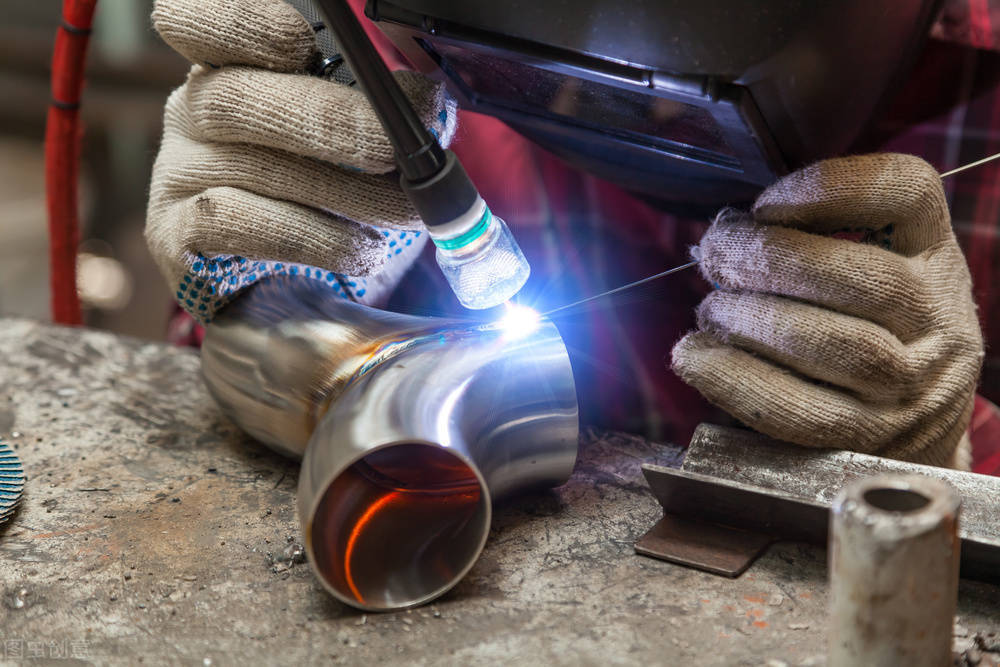TIG वेल्डिंग (TIG, Tungsten Inert Gas Welding), उच्च-परिशुद्धता वेल्डिंग प्रक्रियाको प्रतिनिधिको रूपमा, एयरोस्पेस, आणविक उद्योग, चिकित्सा उपकरण, सटीक निर्माण र अन्य उद्योगहरूमा व्यापक रूपमा प्रयोग गरिन्छ। तर यसको सहज र सुन्दर वेल्ड पछाडि, सजिलै बेवास्ता गरिएका धेरै प्राविधिक विवरणहरू र गलतफहमीहरू लुकाएर, आज हामी व्यावसायिक दृष्टिकोणबाट गहिरो खन्दैछौं जुन तपाईंलाई ती कुराहरू थाहा नहुन सक्छ।
१. TIG सबै वेल्डिङमा "सबैभन्दा नियन्त्रणयोग्य ताप इनपुट" प्रक्रियाहरू मध्ये एक हो।
TIG वेल्डिङस्थिर DC वा AC आउटपुटको साथ, ताप स्रोतको रूपमा नन-पग्लने पोल आर्गन आर्क प्रयोग गर्दछ, धेरै कम ताप इनपुटको सटीक नियन्त्रण महसुस गर्न सक्छ, विशेष गरी निम्नका लागि उपयुक्त:
- पातलो पर्खाल भएका भागहरू (जस्तै ०.३ मिमी स्टेनलेस स्टील)
- थर्मल सामग्री (टाइटेनियम, निकल, म्याग्नेसियम मिश्र धातु)
- प्रेसिजन जोइन्टहरू (जस्तै उपकरणहरूको लागि माइक्रोट्यूबहरू) प्रेसिजन जोइन्टहरू (जस्तै उपकरणहरूको लागि माइक्रोट्यूबहरू) TIG वेल्डिङको बारेमा तपाईंलाई थाहा नहुन सक्ने कुराहरू
MIG वा म्यानुअल आर्क वेल्डिङको तुलनामा, TIG मा सानो ताप-प्रभावित क्षेत्र, घना वेल्ड संरचना र बढी नियन्त्रणयोग्य विकृति हुन्छ।
२. सतह सुन्दर छ ≠ आन्तरिक विश्वसनीयता, उही महत्वपूर्णको पछाडि वेल्डिंग
धेरै वेल्डरहरूलाई बेवास्ता गर्न सजिलो हुन्छ "पछाडिको सुरक्षा"TIG सिक्दा।"
विशेष गरी स्टेनलेस स्टील, टाइटेनियम मिश्र धातु र अन्य धातुको अक्सिडेशनको लागि अत्यन्त संवेदनशील वेल्डिंगमा, यदि पछाडिको भाग आर्गनले भरिएको छैन भने, आन्तरिक अक्सिडेशन तह, डेकार्बुराइजेशन तह, इन्टरग्रान्युलर जंग बिन्दु उत्पन्न गर्न धेरै सजिलो हुन्छ, जसले गर्दा जंग दर बढ्छ, सेवा जीवन उल्लेखनीय रूपमा घट्छ।
समाधान:
- ट्यूब भित्र आर्गन सुरक्षा (पछाडि ग्यास)
- विशेष ग्यास ब्लकिङ रिङ, ग्यास गाइड सिरेमिक प्रयोग गर्नुहोस्
- प्रवाह दर र प्रतिस्थापन समय नियन्त्रण गर्नुहोस् (> भोल्युमको २ गुणा)।
३. आर्गन ग्यासको शुद्धताले वेल्डको गुणस्तर सिधै निर्धारण गर्छ - "९९.९% पर्याप्त छ" भन्ने विश्वास नगर्नुहोस्।
साधारण संरचनात्मक वेल्डिंगमा, औद्योगिक-ग्रेड आर्गन ग्यास (शुद्धता ≥ ९९.९९%) भेट्न सक्छ। यद्यपि, निम्न परिदृश्यहरूको लागि:
- एयरोस्पेस भागहरू
- उच्च भ्याकुम कक्षहरू
- चिकित्सा सफाई प्रणालीहरू
अशुद्धताहरू (जस्तै अक्सिजन, आर्द्रता, हाइड्रोजन) ट्रेस गर्नाले पनि वेल्ड भित्र स्ल्याग, पिनहोल, पोरोसिटी र माइक्रोक्र्याकहरू निम्त्याउन सक्छ।
सिफारिसहरू:
- उच्च-स्तरीय उत्पादनको लागि ≥९९.९९५% शुद्धता भएको आर्गन (५N) लाई प्राथमिकता दिनुहोस्।
- आर्द्रता/शीत बिन्दु अलार्म भएको ग्यास आपूर्ति प्रणाली प्रयोग गर्नुहोस्।
४. टंगस्टन इलेक्ट्रोडका विभिन्न रंगहरू केवल "ब्रान्ड भिन्नता" मात्र होइनन्, तर वेल्डिङ कार्यसम्पादन भिन्नता पनि हुन्।
| टंगस्टन इलेक्ट्रोड रङहरू | सामग्रीहरू | विशेषताहरू | आवेदन सुझावहरू |
| हरियो (WP) | शुद्ध टंगस्टन | आर्क फैलावट, कमजोर सुरुवात | एसी आल्मुनियम वेल्डिङको लागि मात्र |
| रातो (WT20) | २% थोरियमको वेल्डिङ | चापको एकाग्रता, लामो सेवा जीवन | कार्बन र स्टेनलेस स्टीलको डीसी वेल्डिंग (ध्यान दिनुहोस् कि त्यहाँ थोरै रेडियोधर्मिता छ) |
| खैरो (WZr) | जिरकोनियम भएको | प्रदूषणको लागि राम्रो प्रतिरोध | टाइटेनियम मिश्र धातुहरू वेल्डिंगको लागि सिफारिस गरिएको |
| बैजनी (WX) | दुर्लभ-पृथ्वी मिश्र धातुहरू | अत्यधिक बहुमुखी, स्थिर चाप | आधुनिक वेल्डिङ मेसिनहरूको लागि सिफारिस गरिएको |
टंगस्टन इलेक्ट्रोडको गलत छनोटले चापको स्थिरतालाई मात्र असर गर्दैन, तर पग्लिएको पोखरीमा टंगस्टन इलेक्ट्रोड प्रदूषण र समावेशहरूको उत्पादन पनि निम्त्याउँछ।
५. ऐना वेल्डको "सौन्दर्य", सूक्ष्म-धातुकर्म संगठनको परिणाम हो।
TIG वेल्डिङ यसको सहज वेल्ड, माछाको स्केल एकरूपताको लागि परिचित छ, तर यी "उपस्थितिहरू" पछाडि, यसको धेरै कम स्प्याटर र पग्लिएको पोखरीको स्थिर गतिशील व्यवहार हो।
उचित प्यारामिटर नियन्त्रण अन्तर्गत, वेल्डमा राम्रो दानाको आकार, एकरूप संगठन र यान्त्रिक गुणहरू (विशेष गरी थकान जीवन) हुन्छन् जुन अन्य म्यानुअल वेल्डिंग विधिहरू भन्दा उल्लेखनीय रूपमा राम्रो हुन्छन्।
राम्रो गुणस्तरको TIG वेल्डको सूक्ष्म विशेषताहरूमा समावेश छन्:
- समतुल्य क्रिस्टल वा फाइन स्तम्भकार क्रिस्टलहरूको सूक्ष्म संरचना
- कुनै उल्लेखनीय स्ल्याग, पोरोसिटी, दरार छैन
- डक्टाइल फ्र्याक्चर ढाँचाको साथ फ्र्याक्चर
६. TIG वेल्डिङ "ढिलो काम" होइन, तर "अनुप्रयोगहरूको विस्तृत दायरा" हो।
TIG लाई प्रायः ढिलो र उच्च लागत मानिन्छ, तर यसको वास्तविक फाइदाहरू निम्न हुन्:
- धेरै उच्च वेल्ड गुणस्तर नियन्त्रण योग्यता (विशेष गरी उद्योगको शून्य-दोष आवश्यकताहरूमा)
- विभिन्न धातुहरू (स्टील, तामा, आल्मुनियम, आल्मुनियम, निकल, टाइटेनियम, आदि) को लागि प्रयोग गर्न सकिन्छ।
- स्वचालित गर्न सजिलो, जस्तै अर्बिटल स्वचालित TIG, रोबोटिक TIG वेल्डिंग, आदि।
स्वचालित प्रणालीहरूमा, TIG ले प्रति मिनेट दशौं सेन्टिमिटरको वेल्डिंग गतिमा पुग्न सक्छ, जुन विशेष गरी उच्च स्थिरता आवश्यक पर्ने उच्च-भोल्युम उत्पादनको लागि उपयुक्त छ।
७. ग्यास सुरक्षा पछि, वैकल्पिक होइन, तर वेल्डको आयु निर्धारण गर्ने कुञ्जी
TIG वेल्डिङ आर्क अफ मोमेन्टमा, पग्लिएको पोखरी अझै पनि उच्च तापक्रमको अवस्थामा छ, यदि तपाईं तुरुन्तै टर्चबाट टाढा जानुभयो भने, हावामा रहेको अक्सिजन र नाइट्रोजन क्रिस्टलहरूमा प्रवेश गर्न धेरै सजिलो हुन्छ, पोरोसिटी, अक्सिडेशन तहको निर्माण हुन्छ, जसको परिणामस्वरूप वेल्डको प्रारम्भिक विफलता हुन्छ।
व्यावसायिक सल्लाह:
- ग्यास ढिलाइ समय ≥ 3s पछि चाप बन्द गर्नुहोस् (सामग्री अनुसार 6s सम्म ढिलाइ हुन सक्छ)
- ग्यास पूर्ण रूपमा ननिस्केसम्म टर्चको स्थिति परिवर्तन नगर्नुहोस्
- प्यारामिटरहरू सेट गर्न वेल्डरको "ग्यास सुरक्षा" प्रकार्य प्रयोग गर्नुहोस्
८.TIG वेल्डिङ छुट्टै प्रक्रिया होइन, तर "सिस्टम इन्जिनियरिङ" हो।
उत्कृष्ट TIG वेल्डिङ परिणामहरू, जसमा धेरै प्रणालीहरू समावेश छन्:
- विद्युत आपूर्ति प्रणाली (स्थिरता, वर्तमान प्रतिक्रिया)
- ग्यास सुरक्षा प्रणाली (दबाव, शुद्धता, प्रवाह दर)
- प्रक्रिया प्यारामिटरहरू (वर्तमान, भोल्टेज, ध्रुवीयता, तरंगरूप)
- सञ्चालन कौशल (टर्च कोण, तार फिड मोड, बन्दुक गति)
- सहायक नियन्त्रण (जस्तै खुट्टाको पेडल, आर्क स्टार्ट नियन्त्रण मोड, स्वचालन नियन्त्रण) अर्को शब्दमा भन्नुपर्दा, TIG ले "वेल्डर सञ्चालन" गर्दैन, तर **वेल्डिङ इकोसिस्टम** नियन्त्रण गर्छ।
निष्कर्ष
TIG वेल्डिङको "कठिनाई" उपकरणमा होइन, तर विवरण र विशेषज्ञताको अत्यधिक मागमा निहित छ। तर यी विवरणहरूको कारणले गर्दा नै यो सबैभन्दा माग गर्ने उद्योगहरूमा आफ्नो स्थान लिन सक्छ।
यदि तपाईंले यसको पछाडिको विज्ञान बुझ्न सक्नुहुन्छ र यसका लागि आवश्यक पर्ने विशिष्टताहरू लागू गर्न सक्नुहुन्छ भने, तपाईं केवल धातु वेल्डिंग गरिरहनुभएको छैन, तपाईं उच्च-गुणस्तरको औद्योगिक मानक सिर्जना गर्दै हुनुहुन्छ।
पोस्ट समय: अप्रिल-१८-२०२५


